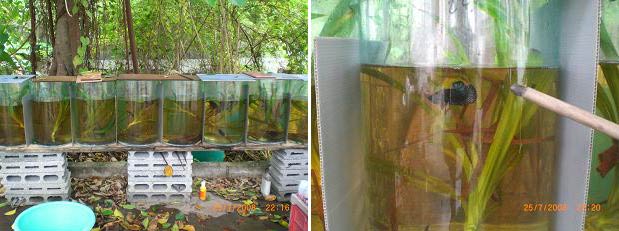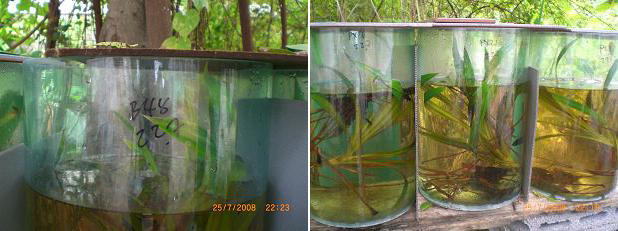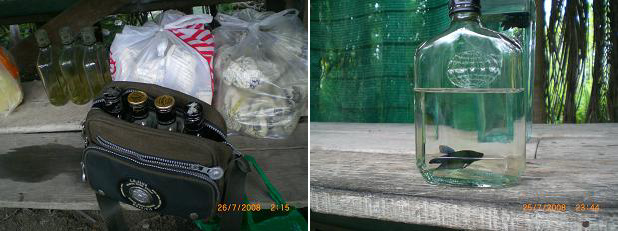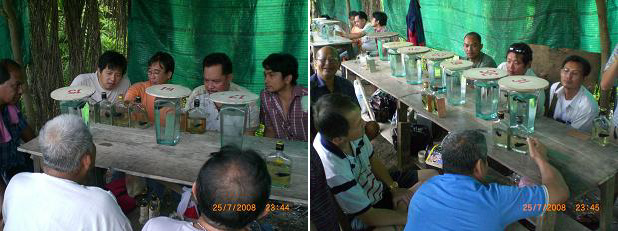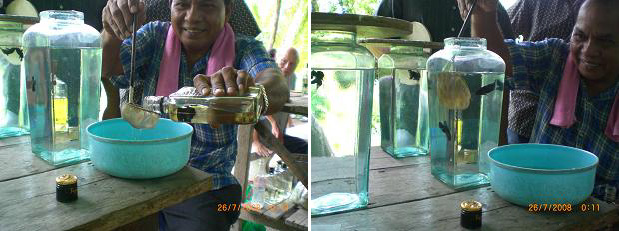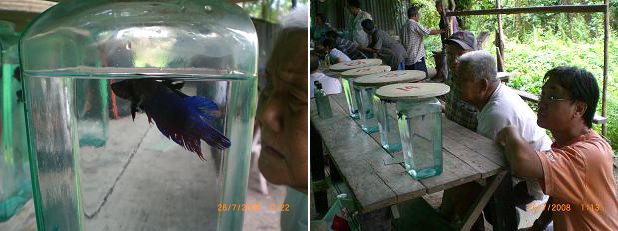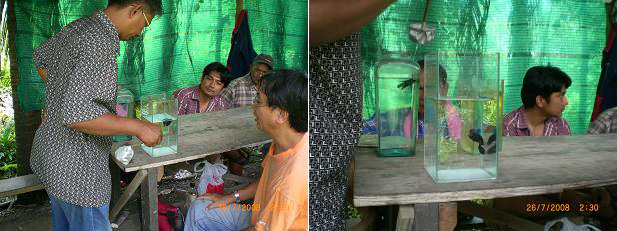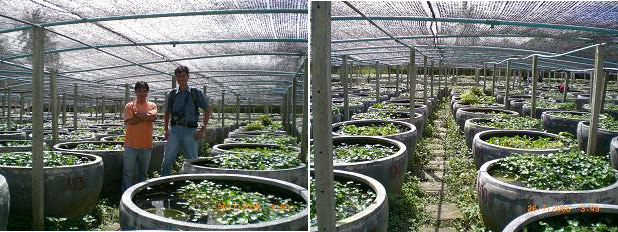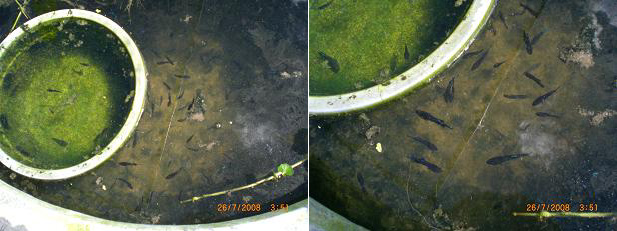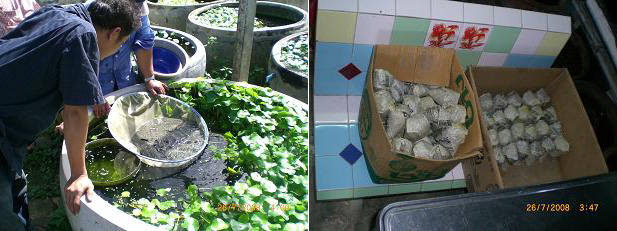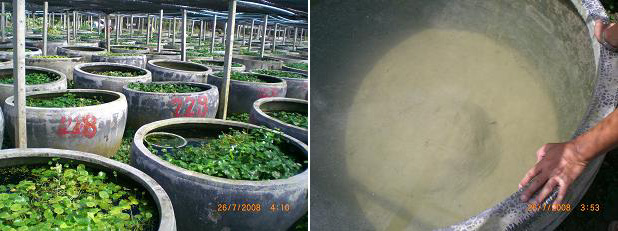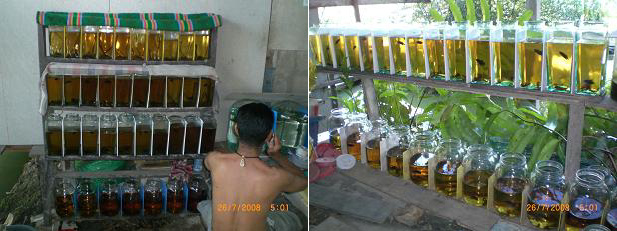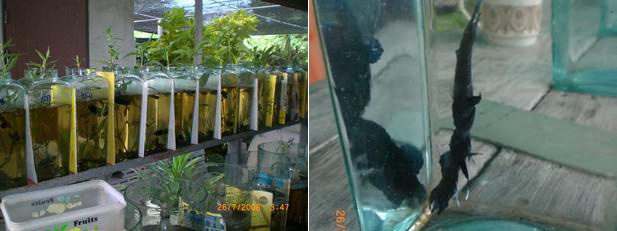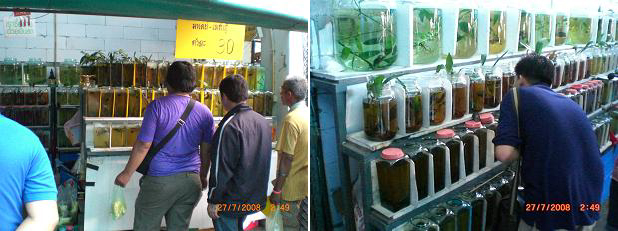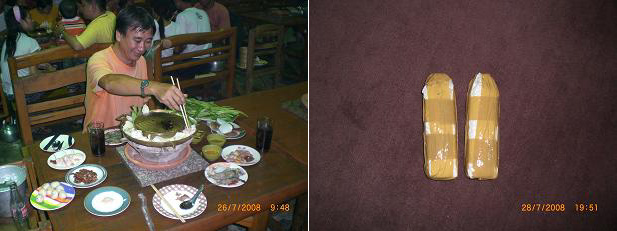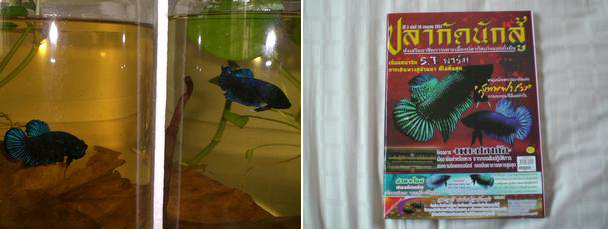
A Short Trip To Thailand
By Redhillbetta :
This web page is about my trip to Thailand, a journey into the land where the betta splendens originated, whose breeders have for hundreds of years bred them for fighting and developed unique strains specially for this game. The Plakat Mhor fighting strains have long being known in the fighting circles as the best in the country, and are the de facto fighters in Central Thailand, namely in the Bangkok area. Bringing to you an experience to savour, by going into the fighting arenas and meeting the players and breeders in the farms, all in the heartland of the Thai fish fighting fraternity. Accompanying me is no other then Mr.Precha Jintasaerewonge himself, a renowned betta specialist and proud owner of the site www.plakatthai.com. Do enjoy the sights and information that I have brought back from Thailand. They are after all my personal opinions, do correct me if I am wrong.
|
|
Precha's Plakat Mhors - Armed to the hilt, equipped with razor sharp teeth, tough mouths, strong and hard bodies, these are his best arena prospect at the moment. His fighters have been known to achieve considerable successes both at home and abroad. I have personally seen some of his male fighters been used as brood stock by local breeders upon retiring from Singapore arenas after recording good wins. |
|
Precha's fighters under going the training phase. Notice the numbers on the tanks, it denotes the families/spawns and dates pertaining to the conditioning and training schedules. |
|
Fighters are brought to the arenas in whisky bottles and are conveniently accommodated in carrier bags. Fighters are sized in such bottles, the caps are rarely opened and players sizes the fish by looking at the side view. Generally they will take only the tallness and length of the fish into consideration during sizing. With this method of sizing the breeders tend to favour in breeding fighters with a larger head (when viewed from the top) as this dimension are usually being ignored by the players, the result is that such fighters will have an added advantage during sizing. The Thai fighters in my view should have very large head (viewed from the top) as long as they do not hinder their fighting performance and are free from unsoundness. |
|
This is the Thonburi arena in the out skirt of Bangkok, one of the many many arenas in Thailand. All the fighters involved are from the Plakat Mhor families, a favoured breed that fight long and hard. What is interesting in Thai arenas are that there are frequent visiting players coming from other towns to challenge the local fish fighters. They bring with them top notch fighters and are willing players for high stakes. Often they will also leave behind their used fighters for local breeders to breed, exerting a beneficial influence on the continuing development of the local breeds. This reflects a similar situation in Singapore whereby Malaysian players regularly bring their fighters over for challenges. Many local players have contacts with their Malaysian counterparts, with the Ipoh strains being the most sort after. Much have been made by local breeders to use neighboring strains for out crossing, but with Singapore fighters, the Ipoh bloodlines might just be the most essential element in the genetic mix. |
|
The arena owner with an old player. The arena has a makeshift food stall selling food and drinks. I had a bottle of mineral water and a meal of rice consisting of one fried egg and Thai styled spicy pork, for only 30 baht or SGD1.22. (they are tasty...Thai food can't be otherwise :)) |
|
Once Thai players find suitable match for their fish, they will gently net their fighters into the fight jars. In Singapore, players are less gentle, they very often pour their fish. (nets are for dead fish :) ) |
|
The Thai fight jars are squared, with the top end 6 to 7 inches wide and starts narrowing towards the bottom. It provides good view from all 4 sides, superior to cylindrical types used in Singapore. Singapore players may find Thai fight bottles small though. Thai players enjoy betting in stages, they may start with a small bet but will increase the stakes gradually over the duration of the fights. This may explain the use of a squared jars for good visibility. Experienced players will sit with the back facing the light source as can be seen by those gentlemen in the picture above. They get the best view, while those facing the light will see silhouettes.... The old man in white did not move his butts through out the duration of the fight, not even leaving the seat to pee. (by the way the arena does not have toilets, they have gone green long time ago) |
|
In Thai arenas, fights are always between 2 fighters and will last within the time frame decided by the referees or agreed upon by the players beforehand. The fight ends with a result when one of the fish gives up and flee or has stopped flaring. Players will call for a "test" when they see one of the fish has stopped flaring or has stopped fighting. A referee will come in and check on the fighters. He will first check if indeed the fighters have stopped their fights, if so he will bring in a new jar with a fresh fish inside. Ideally the fresh fish shall be of equal size to the two existing combatants and they will take turns to be netted into the fresh fish's jar. In arena jargon we call the fresh fish the "police" fish. Both the combatants will have to take five hits from the "police" fish and yet able to flare back or attack, with the weaker of the two challenging the "police" first. The combatants will resume their fights if both has passed the "test", this may go on for many more rounds of "testing" before a winner is finally decided. The number of "test" can also be fixed before hand by the players in which a tie or draw can be concluded if both the combatants have managed to pass all of them. In my opinion I has noticed fewer fatalities in such a ruling with the help of the "police" fish and fight time on average are also shorter. In Singapore there are no "police" fish, very often both combatants are left to soak in the fight bottle for the entire duration of the fights which can last from 3 to 6 hours, by which time some fighters may have succumbed to their injuries and exhaustion and die in the bottles. Singapore players generally prefer fish that will fight till their very last breath and they need not have to flare and some fish may stay motionless to conserve energy to last the scheduled time frame to avoid defeat. Thai fighters on the other hand tends to flare at the least provocation, the Thai arena ruling requires that, and because of this their gill covers are more "flexible" but deemed "soft" by local players. Local fighters are bred to fight aggressively right from the very beginning, relentless in their pursuit to finish off their opponents. Thai fighters take it slow, they favour a long fight and go for the long haul with much patience. Thai fighters only need to keep flaring to remain in the game, calculated and accurate strikes to impede opponents from flaring are favoured over knocking them out of commission. My conclusion on this matter is that the arena ruling will affect the characteristics of the fighters and overtime breeders will gradually optimize their breeding program to take advantage of the prevailing rules and regulations of the respective arenas. The differences in the fish fighting rules and regulations between the two countries also have an effect on how the game are played. In Singapore, players only need to size their fighters and pour their fish into the fight bottle. The fish will do the rest of the job for them, with no further work on the part of the players except to watch. In Thai arenas, wagers may be raised after each and every call for "test", a player thus need to monitor the fights closely in order to exercise sound judgment and uses their experience to take advantage of the situations. Situation awareness is the key in high stakes fights at Thai arenas, knowing when to "chase" and when not to are important. In my opinion Thai fish fighting system is not just a fight between the fishes but also pit players' wits and guts against one another.....certainly asked a lot more from Thai players then their Singapore counterparts.... |
|
The "Police" fish are kept separately in their squared jar, before being put into use they are given a "warm up" session by sparing them with a fighter held within a plastic bag(left picture). This "warm up" sessions are held in the "Police" fish's jar, this will ensure maximizing the territorial instincts of the occupants and brings out their aggression against the intruders. In a closely contested match, when after the stipulated time or both fishes stopped fighting and no clear winner can be sought, "Police" fish are then brought in. Players eagerly awaits the result(right picture), hoping that their fighters will pass the "test". "Police" fish have strong character, they give nothing away and certainly will show no mercy too. |
|
That's me with Precha at a betta farm in Naklon Pathom, a town west of Bangkok. The farm has 1300 ponds, a large one indeed and specializes solely on fighting strain Plakat Mhors. I bought 2 Plakat Mhors from the farm as a souvenir for 50 baht each. (just in case...I am the younger one and slightly taller also) |
|
The betta farm has an entire room for their brood stocks. More than 50 pairs of Plakat Mhors are in their conditioning tanks and countless numbers of individual males and female fighters are kept in square jars, taking up every part of the room. The conditioning of the brood fish may take several days and the males are placed in a small bottle within a larger one where the females reside. All the conditioning jars are filled with mosquito larvae for the fish to eat, many uneaten larvae could be seen wriggling about at the surface(very well fed indeed). Both pictures show the set up of the conditioning tanks for the brood fish. |
|
The fighters in the farm are raised in cylindrical concrete tanks, filled with water plants. The tank measure about 1.5m in diameter and held about 0.8m of water. Sunlight is plentiful, water is fairly clear and the residents are a healthy lot. The fish in the concrete tanks are said to be fed with water fleas, bloodworms and tubifex worms. The feeding trays are positioned close to the surface as can be seen from the above pictures. |
|
A group of players were in the farm sourcing for fighters. I followed them and bought 2 fighters as souvenir from the tank that they had picked their fishes. They bought fishes only from the one tank that held the entire spawn and skipped all the other tanks. In Singapore, players either select or reject the entire spawn, the Thai players are also adhering to this practice, it is universal and it works. |
|
The concrete tanks are well labeled for easy identification of the families residing in them. The base of the tanks are filled with a layer of clay. The picture on the right show a new tank about ready to welcome it's first batch of residents. Like breeders everywhere, all would have their own little secrets in raising their fighters to give each and every fish a winning advantage at the arenas. What I could observe are clay being used at the bottom of the tank, probably to increase the mineral contents of the water. |
|
This is the home of a Thai player, many players like him is also breeders themselves and he owns about one hundred over ponds of Plakat Mhors behind his house. In recent times many young breeders has started to introduce foreign fighters into their bloodlines, many of the out crossed hybrids have done well in the arenas. This player keeps some of his fighters in cylindrical bottles rather then the traditional squared jars, a practice not common in Thailand. In Singapore only display or show strains are kept in squared jars, never the fighting strains. I notice the Thai players are an aesthetic lot, they appreciate their fighters, they fight their fish in squared jars for good visibility, they care for their fighters well, as jar water are usually in pristine condition and fish rooms are neat and tidy. |
|
Thai fighters are conditioned in squared jars similar to those used as fight bottles in the Thai arenas. Singapore and Malaysian players also have similar habits, the purpose is to get their fighters accustom to the fight bottles. With the fight bottles in both Singapore and Malaysia being of rounded type, the players never see a need to use squared jars. By housing their bettas in fight bottles will instill territorial awareness in the fish with the bottles. In the arenas, the fighters will have the illusion as if they are fighting in their own respective "home" bottles and will fight longer and harder. |
|
At Jartujak market's fighter specialty shops. Many such shops are set up in the market, the fighters are all displayed neatly on the shelves with water plants in aged IAL water. In one of the shops they even set up a mini arena to fight fish. Large cylindrical tanks with crystal clear water and some plants are used for training the fighters. It is certainly a one stop location for all your fighter needs, from accessories to feeds, to fighters, trained or untrained and come with an arena to boot. |
|
After a day at the arena, visiting the farms, Jartujak Market and meeting players, it was already nightfall and we headed for our dinner of steam boat cum barbeque.(Buffet style 99 baht per head or SGD4.06) The Thai hot sauces were fantastic, they came in many flavours, definitely one would suit your palate. I packed my two souvenir in plastic bottles and water proofed them before dumping them in my luggage bag. |
|
My two souvenir, Thai bred Plakat Mhors at home. I also brought home a Thai magazine on Fighting Plakats, though I knew nothing about the Thai language and script. |
|
email: redhillbetta@yahoo.com.sg |
